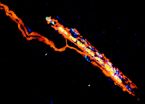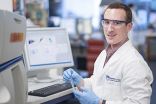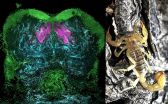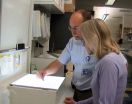Stem cells born out of indecision
2014-12-18
(Press-News.org) This latest research by Joshua Brickman and his research team from Danish Stem Cell Center (Danstem) at the University of Copenhagen specifically found that inhibiting or blocking stem cells ability to make a specific decision, leads to better cell growth and could lead to defined ways to differentiate stem cells.
This research is the first comprehensive analysis of a pathway important for stem and cancer cell decisions known as Erk. As a result this work could contain clues to cancer treatment as well as helping to establish a platform to make stem cell treatments for gut related disorders like the pancreas or the liver.
The research results have just been published in Cell Reports.
Blocking choices
"If you block all the choices they can make, they stay in the stem cell state. If you only allow them one door to exit from the stem cell state, you should be able to make particular cell types more efficiently. So if you only leave one door open then it's the path of least resistance and when you give them a push they really go," says Professor Joshua Brickman.
As embryonic stem cells can become any cell type in the body, they have to make choices. Based on this research, it appears that blocking these choices is the key to making them grow as stem cells. In other words, if these choices are removed the cells simply reproduce more stem cells.
Embryonic stem cells
In an embryo, cells like embryonic stem cells exist very briefly, quickly differentiating into other cell types that will go on to make the entire organism. This new study shows that chemicals traditionally used to grow embryonic stem cells act to block different choices that they would normally make. By blocking these choices, scientists can then transform these cells from the embryo into embryonic stem cells and grow them indefinitely in a dish.
"This creates an intellectual framework to help establish tissue techniques for other stem cells populations and represents a new paradigm for how we think about embryonic stems cells and how we maintain them," says Postdoc William Hamilton from DanStem.
By forcing a cell to go through a particular door by virtue of closing all the other doors, the scientists know need to know what the door is. "On a scientific level we would now like to know what the lock and key looks like and then we can understand how many more doors there are," adds Professor Joshua Brickman.
INFORMATION:
ELSE PRESS RELEASES FROM THIS DATE:
2014-12-18
After an incomplete spinal cord injury, the body can partially recover basic motor function. So-called muscle spindles and associated sensory circuits back to the spinal cord promote the establishment of novel neuronal connections after injury. This circuit-level mechanism behind the process of motor recovery was elucidated by Prof. Silvia Arber's research group at the Biozentrum, University of Basel and the Friedrich Miescher Institute for Biomedical Research. Their findings may contribute to designing novel strategies for treatment after spinal cord injuries and have ...
2014-12-18
Walter and Eliza Hall Institute researchers have for the first time revealed how dying cells are hidden from the immune 'police' that patrol the body.
The research answers a decades-old mystery about the death of cells, which in some situations can alert the immune system to potential danger, but in other circumstances occurs 'silently', unnoticed by immune cells.
Silent cell death, or apoptosis, is a controlled way for the body to eliminate cells that may be damaged, old, or surplus to the body's requirements, without causing collateral damage. This 'normal' cell death ...
2014-12-18
This news release is available in Spanish. The genome is the cell's book of instructions. All the cells in our body contain the same genomic information but each of them "reads" the gene fragments that interest them in order to carry out their function. So, neurones, hepatocytes and cardiac cells are different although their genome is the same. In order to achieve this huge variety of functions from the same genome, the cells employ a mechanism known as alternative splicing. This enables them to combine several fragments - known as exons - from the same genes in order ...
2014-12-18
Mountain View, Calif. - December 18, 2014 - 23andMe, Inc., the leading personal genetics company, today announced the publication of a study that pinpoints fine-scale differences in genetic ancestry of individuals from across the United States.
Since immigrants first arrived more than four hundred years ago, the United States has served as a meeting place for peoples from different continents. This study illuminates how American history and the ongoing mixing of peoples with African, European, and American origins can be seen in our DNA.
"The relationship between genomics ...
2014-12-18
HOUSTON - (Dec. 18, 2014) - Cars that run on natural gas are touted as efficient and environmentally friendly, but getting enough gas onboard to make them practical is a hurdle. A new study led by researchers at Rice University promises to help.
Rather than shoehorn bulky high-pressure tanks like those used in buses and trucks into light vehicles, the Department of Energy (DOE) encourages scientists to look at new materials that can store compressed natural gas (CNG) at low pressure and at room temperature. Cage-like synthetic macromolecules called metal organic frameworks ...
2014-12-18
LA JOLLA, CA--December 18, 2014--Collaborating scientists from The Scripps Research Institute (TSRI) and the University of California (UC) San Diego have developed a powerful new system for studying how proteins and other biological molecules form and lose their natural folded structures.
Using the new system, researchers can force a sample of molecules to unfold and refold by boosting and then dropping the temperature, so quickly that even some of the fastest molecular folding events can be tracked.
"One way of studying these structures has been to make them unfold ...
2014-12-18
Whether you're cramming for an exam or just trying to remember where you put your car keys, learning and memory are critical functions that we constantly employ in daily life.
It turns out that the structure and function of brain centers responsible for learning and memory in a wide range of invertebrate species may possibly share the same fundamental characteristics, according to a new study published in the journal Current Biology and performed by University of Arizona neuroscientists Nicholas Strausfeld, Regents' Professor in the Department of Neuroscience, part of ...
2014-12-18
ST. LOUIS - Saint Louis University research findings published in the December issue of Antimicrobial Agents and Chemotherapy report a family of molecules known as nucleotidyltransferase superfamily (NTS) enzyme inhibitors are promising candidates for new herpes virus treatments.
The findings could lead to new treatment options for herpes that patients can use in conjunction with or instead of currently approved anti-viral medications like Acyclovir. Researcher Lynda A. Morrison Ph.D., professor of Molecular Microbiology and Immunology at Saint Louis University, likened ...
2014-12-18
Why are older people at higher risk for developing cancer? Prevailing opinion holds that, over time, your body's cells accumulate DNA damage and that eventually this damage catches up with the body in a way that causes cancer. A University of Colorado Cancer Center study published today in the journal Aging shows that this prevailing opinion is incomplete. In addition to DNA damage, cancer depends on the slow degradation of tissue that surrounds cancer cells, something that naturally comes with aging.
"It's really all about natural selection and survival of the fittest," ...
2014-12-18
Illinois is the most critical hub in the network of U.S. domestic food transfers, according to a new study by Megan Konar, an assistant professor of civil and environmental engineering, and colleagues at the University of Illinois at Urbana-Champaign. The study was published in the journal Environmental Science and Technology.
Much like the national airport network in which O'Hare International Airport is a major hub, Illinois plays the most central role in distributing food across the U.S. According to the report, the U.S. food network moves more than 400 million tons ...
LAST 30 PRESS RELEASES:
[Press-News.org] Stem cells born out of indecision





